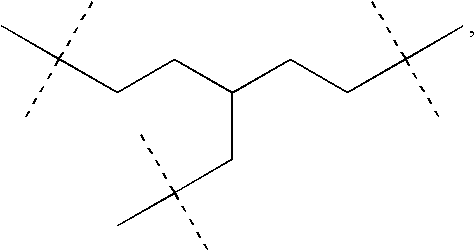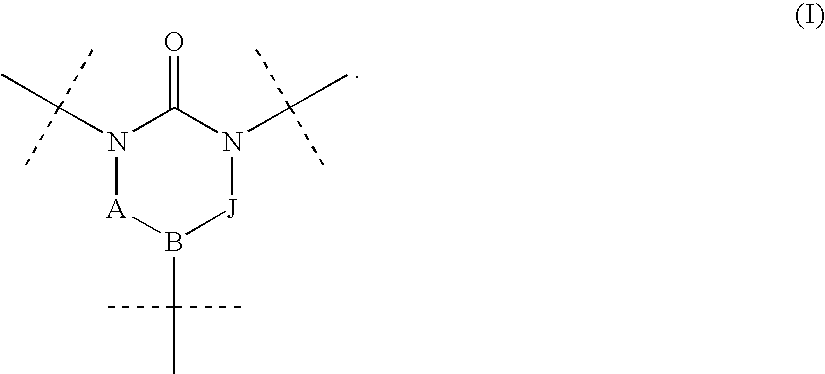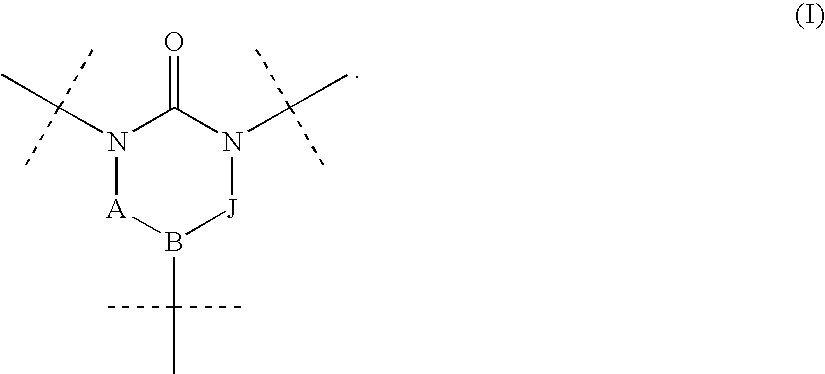Photochemical crosslinkers for polymer coatings and substrate tie-layer
a crosslinker and photochemical technology, applied in the field of crosslinkers, can solve problems such as difficulty in dissolving in aqueous systems
- Summary
- Abstract
- Description
- Claims
- Application Information
AI Technical Summary
Benefits of technology
Problems solved by technology
Method used
Image
Examples
example 1
Synthesis of Trifunctional Triazine Crosslinker
[0342]1.2 g (4 mmol) of triglycidyl isocyanurate (Aldrich Chemicals, Milwaukee, Wis.) and 2.4 g (12 mmol) of 4-hydroxybenzophenone (Aldrich Chemicals, Milwaukee, Wis.) were mixed in a 50-ml round bottom flask containing a magnetic stir bar. The flask was flushed with argon for 10 min and heated to 130° C. in an oil bath. Once the reaction mixture melted, 6 mg (0.02 mmol) of triphenylphosphine (Aldrich Chemicals, Milwaukee, Wis.) was added. The mixture was stirred for another 2 minutes under argon and cooled to room temperature. The reaction residue was dissolved in 30 ml chloroform, then washed with 4N NaOH (30 ml×3) and deionized water (30 ml×3). The organic layer was dried over magnesium sulfate and concentrated to dryness on the under reduced pressure. The product was purified by column chromatography (silica gel, 230-400 mesh, Whatman, Inc.) using ethyl acetate as eluent (Rf˜4.5). The fractions containing the pure product were combi...
example 2
Application of Triazine Crosslinker to Create a Photoreactive Surface
[0345]A photoreactive poly(ε-caprolactone) (PCL) film was prepared by incorporating the crosslinker in a film casting polymer solution. A solution containing 20 mg / ml PCL (Aldrich Chemicals, Milwaukee, Wis.) and 0.4 mg / ml triazine crosslinker (as prepared in Example 1) was cast onto a glass slide. 10 μl of 50 mg / ml poly(vinylpyrrolidone) (PVP), 30K, Kollidon K30 BASF, NJ) in isopropanol solution was added onto the film. After complete evaporation of the isopropanol, the film was illuminated under UV for 20 minutes (UV Crosslinker, UVP CL-1000, Upland, Calif., 254 nm light, 120,000 μJ / cm2). The coated film was incubated in deionized water on a shaker for 3 hours to remove unbound PVP. A homogeneous PVP coating could be seen on the PCL film by staining with a solution of Congo Red (0.5% w / v aqueous solution) indicating a uniform distribution of crosslinker on the film surface. A PCL film without triazine crosslinker ...
example 3
Synthesis of Photoreactive Glycol Crosslinker
[0346]2.26 g 4-hydroxybenzophenone (Aldrich Chemicals, Milwaukee, Wis.) was dissolved in 50 ml of acetone, and 0.532 ml of glycerol triglycidyl ether (Polysciences, Warrington, Pa.), and 3.3 g potassium carbonate (Aldrich Chemicals, Milwaukee, Wis.) were added to the solution. The reaction mixture was heated to reflux over 24 hours. After 24 hours of heating, thin layer chromatography (TLC) showed consumption of the glycerol starting material (eluent 20:1 Chloroform:methanol) and the emergence of three uv active spots. The acetone was removed by rotary evaporation and the residue was dissolved in chloroform, and filtered. The resulting chloroform solution was washed three times with 4N NaOH aqueous solution, once with deionized water, then twice with 1N HCl aqueous solution, and three times again with deionized water. The chloroform solution was dried over magnesium sulfate, filtered, and the solvent removed by rotary evaporation. The res...
PUM
| Property | Measurement | Unit |
|---|---|---|
| solubility | aaaaa | aaaaa |
| length | aaaaa | aaaaa |
| diameter | aaaaa | aaaaa |
Abstract
Description
Claims
Application Information
 Login to View More
Login to View More - R&D
- Intellectual Property
- Life Sciences
- Materials
- Tech Scout
- Unparalleled Data Quality
- Higher Quality Content
- 60% Fewer Hallucinations
Browse by: Latest US Patents, China's latest patents, Technical Efficacy Thesaurus, Application Domain, Technology Topic, Popular Technical Reports.
© 2025 PatSnap. All rights reserved.Legal|Privacy policy|Modern Slavery Act Transparency Statement|Sitemap|About US| Contact US: help@patsnap.com



